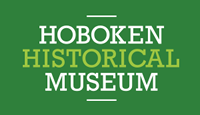I Belong: A History of Civic and Social Clubs in Hoboken
July – December 2012

Hoboken has always been a haven for newcomers. So perhaps it’s not surprising that from as early as the 1700s, social clubs have sprung up as a way for people to connect with others around shared interests. From purely social groups like the Turtle Club—an eating and drinking society—to organizations devoted to civic and social philanthropy, along with special-interest clubs for theater, debate and sports, Hoboken has spawned a colorful array of clubs that reflect its citizens’ diverse interests and backgrounds.
I Belong: A History of Civic and Social Clubs in Hoboken traced a colorful history of a wide variety of organizations that have forged bonds among Hoboken’s residents over the years. Exhibit curators Bob Foster, Dr. Christina Ziegler-McPherson, and Eileen Lynch have unearthed more than 250 clubs, and tell their stories through displays of photographs, uniforms, medals, event programs, trophies and other artifacts from the Museum collections and other sources. A photograph of one of the clubs was blown up to life-size, so visitors could photograph themselves as a member of the club.
The show was on view for six months and included talks and lectures by noted historians such as historian, author and local resident Dr. Ziegler-McPherson and Daniel Soyer, a historian who writes about mutual aid societies and fraternal organizations.
Buildings erected by a few of these clubs are visible today around Hoboken. Some groups built impressive club headquarters, like the Benevolent and Protective Order of Elks, Lodge 74, built in 1906 at 1005 Washington St., which continues today as an active civic group, and the Independent Order of Odd Fellows, which no longer has a local chapter, but met at a building that stood at 412 – 414 Washington St., which until recently housed a Blockbuster video store at street level.
The Columbia Club at 1101 Bloomfield St. was built to impress in 1891 by some of the most prominent men in Hoboken. Designed in the once-fashionable “Richardson Romanesque” style, with rounded arches and contrasting color bands, the Columbia Club continues to impress. Its spacious, mahogany-paneled rooms for receptions and lectures reflected the group’s lofty aspiration to promote cultural and civic improvement projects, but within 20 years, the group had disbanded, and the building was taken over by a Masonic lodge for a few decades. In the 1980s, the building was rescued, restored and converted into four condominiums that retain many of the original architectural details.
Still standing on Newark St. is the clubhouse of the Hudson County Pigeon Club, built shortly after World War II (and now rented to a recording studio of the same name). Founded in 1922, HCPC once had over 70 members and sponsored the Hoboken Derby, one of the most famous races in North America. Members kept pigeon coops on rooftops, much like the one seen in the movie “On the Waterfront.” Club member Vinnie Torre still maintains his Hillside Loft on Monroe St. and shared his memories of the group’s glory days in an oral history chapbook, “The Pigeon Guys,” available at the Museum or downloadable on our website; click here to visit the oral history page.
Some former clubhouses have been replaced by modern interpretations of the original structure. The Union Club at 6th and Hudson Streets was originally built by the Deutscher Club in 1863 – 64, but the group changed names during World War I when German-Americans were closely monitored on suspicion of espionage. The building that stands there now sports a columned portico reminiscent of the original.
Another homage to a famous Hoboken-based club is the small building on Maxwell Place Park built to resemble one that belonged to the New York Yacht Club. Despite its name, the group had a clubhouse in Hoboken, and elected John Cox Stevens as its first commodore. With his brother Edwin, these sons of Hoboken founder Col. John Stevens helped design and sail the famous yacht America to Britain in 1851 to capture the cup that became the coveted trophy of the America’s Cup Yacht Race. The New York Yacht Club was just one of many boating clubs based in Hoboken, which competed fiercely in local and international races.
One of Hoboken’s earliest social groups dates to 1796, when dozens of gourmands came from all over the region to dine on turtle soup and indulge their palates in an smorgasbord of food and drink. There’s a fascinating story behind the original Turtle Club, whose reputation was such that its feasts—and accounts of prodigious drinking—were reported in The New York Times. These groups and others, including Masonic lodges, mutual-aid societies and theater clubs, are echoed in the many social clubs that make Hoboken such a welcoming place for newcomers today.
The exhibit was made possible through funding from the New Jersey Historical Commission, Applied Companies, Bijou Properties, Provident Bank, United Way of Hudson County, and John Wiley & Sons.
